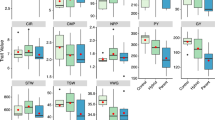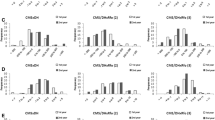Abstract
This study quantified the magnitude of heterosis in pearl millet (Pennisetum glaucum) topcross hybrids produced by crossing 16 diverse landraces and three high yielding open-pollinating varieties on two homozygous male-sterile lines. Hybrids and pollinators were grown in 12 year ×;location combinations in India that were grouped into three zones. Genetic components of variance quantifying the differences among these hybrids were estimated. The hybrids showed a conspicuous heterosis for grain yield, earliness and biomass yield but not for straw yield. The level and direction of heterosis for time to flowering depended strongly on the earliness of the male-sterile line. In the terminal drought stress zone hybrids made on the early maturing male-sterile line 843A had the highest level of heterosis for grain yield (88%). This was partly due to escape from terminal stress. In the other two zones the heterosis for grain yield was on average 30%. Heterosis for biomass yield and biomass yield per day was on average also positive in all three zones. For all traits, except time to flowering and biomass yield per day, pollinator effects were the only significant source of variation. Differences between hybrids were mostly caused by additive genetic effects. Significant amount of heterosis observed in landrace-based topcross hybrids for grain yield and other productivity-related traits suggested that substantial improvement in pearl millet productivity in and environments can be obtained by topcrossing locally adapted landraces on suitable male-sterile lines.
Similar content being viewed by others
References
Bidinger, F.R. &; P. Parthasarathy Rao, 1990. Genetic and cultural improvement in the production of pearl millet. In: S.K. Sinha, P.V. Sane, S.C. Bhargava &; R.K. Agarwal (Eds.), Proc Intern Cong Plant Physiol Vol. I. pp. 194–206. Society for Plant Physiology and Biochemistry, New Delhi, India.
Bidinger, F.R., E. Weltzien-Rattunde, V. Mahalakshmi, S.D. Singh &; K.P. Rao, 1994. Evaluation of landrace topcross hybrids of pearl millet for arid zone environments. Euphytica 76: 215–226.
Burton, G.W., 1965. Pearl millet 23A1 released. Crops Soils 17: 19.
Burton, G.W. &; J.B. Powell, 1968. Pearl millet breeding and cytogenetics. Adv Agron 20: 50–87.
Ceccarelli, S., 1994. Specific adaptation and breeding for marginal conditions. Euphytica 77: 205–219.
Ceccarelli, S., E. Acevedo &; S. Grando, 1991. Breeding for yield stability in unpredictable environments: single traits, interaction between traits and architecture of genotypes. Euphytica 56: 169–185.
CSSA (Crop Science Society of America), 1984. Genetic contribution of yield gains of five major crop plants. In: W.R. Fehr (Ed.), American Society of Agronomy, Madison, WI, USA.
Dave, H.R., 1987. Pearl millet hybrids. In: Proc Internl Pearl Millet Workshop, 7-11 April, 1986, pp. 121–127. International Crops Research Institute for the Semi-Arid Tropics, Patancheru 502 324, India.
Hallauer, A.R. &; J.H. Miranda, 1981. Quantitative genetics in maize breeding. Iowa State University Press, Ames, Iowa, USA.
Haussmann, B.I.G., A.B. Obilana, A. Blum, P.O. Ayiecho, W. Schipprack &; H.H. Geiger, 1998. Hybrid performance of sorghum and its relationship to morphological and physiological traits under variable drought stress in Kenya. Plant Breed 117: 223–229.
Hayes, H.K., 1952. Development of the heterosis concept. In: J.W. Gowen (Ed.), Heterosis, pp. 49–65. Iowa State College Press, Ames, IA, USA.
Jansen, H.G.P., 1989. Adoption of modern cereal cultivars in India: determinates and implication of interregional variation in the spread and ceiling of diffusion. Ph D Thesis, Cornell University, Ithaca, NY, USA.
Kelley, T.G., P. Parthasarathy Rao, E. Weltzien-Rattunde &; M.L. Purohit, 1996. Adoption of improved cultivars of pearl millet in an arid environment: straw yield and quality considerations in western Rajasthan. Expl Agric 32: 161–171.
Mahalakshmi, V., F.R. Bidinger, K.P. Rao &; D.S. Raju, 1992. Performance and stability of pearl millet topcross hybrids and their pollinators. Crop Sci 32: 928–932.
Ouendeba, B., G. Ejeta, W.E. Nyquist, W.W. Hanna &; A. Kumar, 1993. Heterosis and combining ability among African pearl millet landraces. Crop Sci 33: 735–739.
Pethani, K.V. &; H.R. Dave, 1992. Heterosis for grain yield in pearl millet (Pennisetum typhoides (B.) S. &; H.). Indian J Genet Pl Breed 52: 45–49.
Roy, N.N. &; O.R. Murty, 1970. A selection procedure in wheat for stress environments. Euphytica 19: 509–521.
Steel, R.G.D. &; J.H. Torrie, 1960. Principles and procedures of statistics. McGraw Hill Publishers, New York, USA.
Virk, D.S., 1988. Biometrical analysis in pearl millet-a review. Crop Improv 15: 1–29.
Weltzien, E. &; J.R. Witcombe, 1989. Pearl millet improvement for the Thar desert, Rajasthan, India. Vort Pflanzenzüch 15: 23–26.
Weltzien, E. &; G. Fischbeck, 1990. Performance and variability of local barley landraces in near-eastern environments. Plant Breed 104: 58–67.
Weltzien-Rattunde, E., M.L. Whitaker, H.F.W. Rattunde, M. Dhamotharan &; M.M. Anders, 1998. Participatory approaches in pearl millet breeding. In: J.R. Witcombe, D.S. Virk &; J. Farrington (Eds.), Seeds of choice: making the most of new varieties for small farmers, pp. 143–170. Oxford &; IBH Publishing Co Pvt Ltd, Delhi, India.
Wricke, G. &; W.E. Weber, 1986. Quantitative Genetics and Selection in Plant Breeding. Walter de Gruyter, Berlin, Germany.
Yadav, O.P. &; E. Weltzien-Rattunde, 1998. New pearl millet populations for Rajasthan, India. Integrated Systems Project Report No. 10, 88 pp. International Crops Research Institute for the Semi-Arid Tropics, Patancheru 502 324 India.
Yadav, R.P. &; S.P. Singh, 1970. Effect of heterosis on growth rate in pearl millet (Pennisetum typhoides (Burm. F.) Stapf &; C.E. Hubb.). Indian J Agric Sci 40: 428–430.
Author information
Authors and Affiliations
Rights and permissions
About this article
Cite this article
Yadav, O., Weltzien-Rattunde, E., Bidinger, F. et al. Heterosis in landrace-based topcross hybrids of pearl millet across arid environments. Euphytica 112, 285–295 (2000). https://doi.org/10.1023/A:1003965025727
Issue Date:
DOI: https://doi.org/10.1023/A:1003965025727




